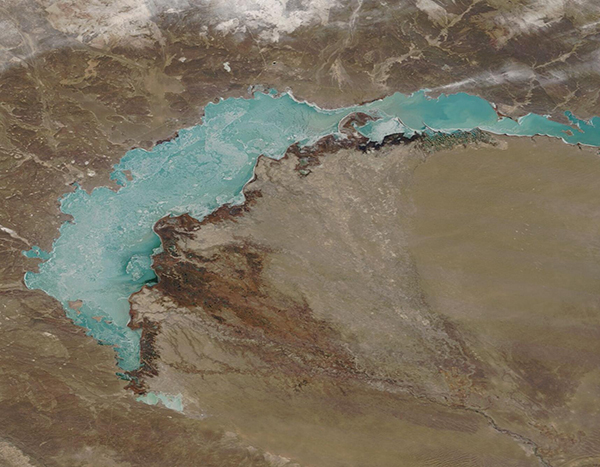Images
December 6, 2021 - Ice formation on Lake Balkhash
Tweet
On November 29, 2021, the Moderate Resolution Imaging Spectroradiometer (MODIS) on board NASA’s Terra satellite acquired a true-color image of an icy Lake Balkhash.
Frigid weather comes fast to east-central Kazakhstan, and as temperatures drop, ice forms quickly. On November 12, satellite imagery revealed no ice on Lake Balkhash and temperatures in the city of Balkhash, located on the northern shore of the lake, ranged from a high of 41˚F (5˚C) to a low of 23˚F (5˚C). By November 19, the city sat under significant cloud cover and registered lows of about 1˚F (-17.2˚C) with a maximum temperature of 21˚F (-6˚C). By November 20, the clouds parted to reveal ice clinging to the southwestern shoreline and a small amount of floating ice in the western section of the lake. Nine days later, this image reveals that almost all of the western portion of Lake Balkhash was covered by ice, but the eastern section remained ice-free.
Spanning an area of 17,000 square kilometers (6,564 sq. mi), Lake Balkhash is the largest lake in Central Asia and the fifteenth largest in the world. A narrow constriction near the center of the lake splits it into two portions, each significantly different than the other. The western part of the lake receives water from the large Ile River, and so the water here is nearly fresh, unlike the brackish and saline eastern section. The western section is wide, shallow, and usually murkier than the eastern part as the wind and currents easily cause sediments from the lake’s bottom to be suspended in the water. Fresh water freezes more quickly than salty water and shallow lakes cool more quickly than deep lakes, so it only makes sense that the western portion of Lake Balkhash ices up more quickly than the saline and deep eastern section.
Image Facts
Satellite:
Terra
Date Acquired: 11/29/2021
Resolutions:
1km (149.1 KB), 500m (410.4 KB), 250m (249.4 KB)
Bands Used: 1,4,3
Image Credit:
MODIS Land Rapid Response Team, NASA GSFC
Tweet
On November 29, 2021, the Moderate Resolution Imaging Spectroradiometer (MODIS) on board NASA’s Terra satellite acquired a true-color image of an icy Lake Balkhash.
Frigid weather comes fast to east-central Kazakhstan, and as temperatures drop, ice forms quickly. On November 12, satellite imagery revealed no ice on Lake Balkhash and temperatures in the city of Balkhash, located on the northern shore of the lake, ranged from a high of 41˚F (5˚C) to a low of 23˚F (5˚C). By November 19, the city sat under significant cloud cover and registered lows of about 1˚F (-17.2˚C) with a maximum temperature of 21˚F (-6˚C). By November 20, the clouds parted to reveal ice clinging to the southwestern shoreline and a small amount of floating ice in the western section of the lake. Nine days later, this image reveals that almost all of the western portion of Lake Balkhash was covered by ice, but the eastern section remained ice-free.
Spanning an area of 17,000 square kilometers (6,564 sq. mi), Lake Balkhash is the largest lake in Central Asia and the fifteenth largest in the world. A narrow constriction near the center of the lake splits it into two portions, each significantly different than the other. The western part of the lake receives water from the large Ile River, and so the water here is nearly fresh, unlike the brackish and saline eastern section. The western section is wide, shallow, and usually murkier than the eastern part as the wind and currents easily cause sediments from the lake’s bottom to be suspended in the water. Fresh water freezes more quickly than salty water and shallow lakes cool more quickly than deep lakes, so it only makes sense that the western portion of Lake Balkhash ices up more quickly than the saline and deep eastern section.
Image Facts
Satellite:
Terra
Date Acquired: 11/29/2021
Resolutions:
1km (149.1 KB), 500m (410.4 KB), 250m (249.4 KB)
Bands Used: 1,4,3
Image Credit:
MODIS Land Rapid Response Team, NASA GSFC




